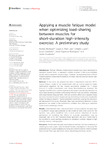Mostrar o rexistro simple do ítem
Applying a muscle fatigue model when optimizing load-sharing between muscles for short-duration high-intensity exercise: A preliminary study
| dc.contributor.author | Michaud, Florian | |
| dc.contributor.author | Frey-Law, Laura A. | |
| dc.contributor.author | Lugrís-Armesto, Urbano | |
| dc.contributor.author | Cuadrado, Lucía | |
| dc.contributor.author | Figueroa-Rodríguez, Jesús | |
| dc.contributor.author | Cuadrado, Javier | |
| dc.date.accessioned | 2023-10-06T06:53:39Z | |
| dc.date.available | 2023-10-06T06:53:39Z | |
| dc.date.issued | 2023-04 | |
| dc.identifier.citation | Michaud F, Frey-Law LA, Lugrís U, Cuadrado L, Figueroa-Rodríguez J and Cuadrado J (2023), Applying a muscle fatigue model when optimizing loadsharing between muscles for shortduration high-intensity exercise: A preliminary study. Front. Physiol. 14:1167748. doi: 10.3389/fphys.2023.1167748 | es_ES |
| dc.identifier.issn | 1664-042X | |
| dc.identifier.uri | http://hdl.handle.net/2183/33543 | |
| dc.description.abstract | [Abstract] Introduction: Multiple different mathematical models have been developed to represent muscle force, to represent multiple muscles in the musculoskeletal system, and to represent muscle fatigue. However, incorporating these different models together to describe the behavior of a high-intensity exercise has not been well described. Methods: In this work, we adapted the three-compartment controller (3CCr) muscle fatigue model to be implemented with an inverse-dynamics based optimization algorithm for the muscle recruitment problem for 7 elbow muscles to model a benchmark case: elbow flexion/extension moments. We highlight the difficulties in achieving an accurate subject-specific approach for this multi-level modeling problem, considering different muscular models, compared with experimental measurements. Both an isometric effort and a dynamic bicep curl were considered, where muscle activity and resting periods were simulated to obtain the fatigue behavior. Muscle parameter correction, scaling and calibration are addressed in this study. Moreover, fiber-type recruitment hierarchy in force generation was added to the optimization problem, thus offering an additional novel muscle modeling criterion. Results: It was observed that: i) the results were most accurate for the static case; ii) insufficient torque was predicted by the model at some time points for the dynamic case, which benefitted from a more precise calibration of muscle parameters; iii) modeling the effects of muscular potentiation may be important; and iv) for this multilevel model approach, the 3CCr model had to be modified to avoid reaching situations of unrealistic constant fatigue in high intensity exercise-resting cycles. Discussion: All the methods yield reasonable estimations, but the complexity of obtaining accurate subject-specific human models is highlighted in this study. The proposed novel muscle modeling and force recruitment criterion, which consider the muscular fiber-type distinction, show interesting preliminary results. | es_ES |
| dc.description.sponsorship | Ministerio de Ciencia e Innovación; PGC 2018-095145-B-I00 | es_ES |
| dc.description.sponsorship | Xunta de Galicia; ED431C2019/29 | es_ES |
| dc.description.sponsorship | Xunta de Galicia; 2022/CP/048 | es_ES |
| dc.language.iso | eng | es_ES |
| dc.publisher | Frontiers | es_ES |
| dc.relation.uri | https://doi.org/10.3389/fphys.2023.1167748 | es_ES |
| dc.rights | Atribución 3.0 España | es_ES |
| dc.rights.uri | http://creativecommons.org/licenses/by/3.0/es/ | * |
| dc.subject | Muscle force | es_ES |
| dc.subject | Multibody dynamics | es_ES |
| dc.subject | Injury prevention | es_ES |
| dc.subject | Sport performance | es_ES |
| dc.subject | Muscle fatigue model | es_ES |
| dc.subject | Musculotendon model | es_ES |
| dc.subject | Musculotendon dynamic | es_ES |
| dc.subject | Ergonomics | es_ES |
| dc.title | Applying a muscle fatigue model when optimizing load-sharing between muscles for short-duration high-intensity exercise: A preliminary study | es_ES |
| dc.type | info:eu-repo/semantics/article | es_ES |
| dc.rights.access | info:eu-repo/semantics/openAccess | es_ES |
| UDC.journalTitle | Frontiers in Physiology | es_ES |
| UDC.volume | 14 | es_ES |
| UDC.startPage | 1 | es_ES |
| UDC.endPage | 16 | es_ES |
| dc.identifier.doi | https://doi.org/10.3389/fphys.2023.1167748 |
Ficheiros no ítem
Este ítem aparece na(s) seguinte(s) colección(s)
-
LIM - Artigos [43]






